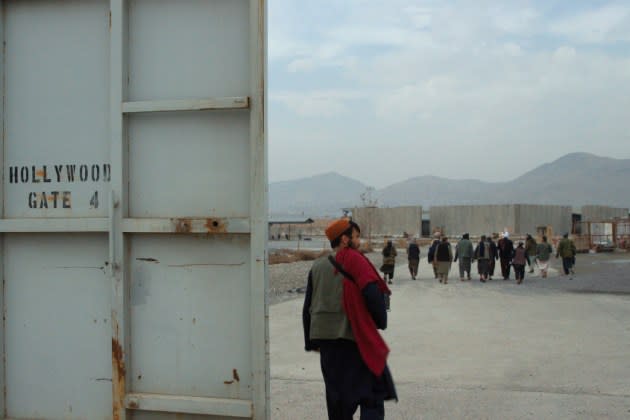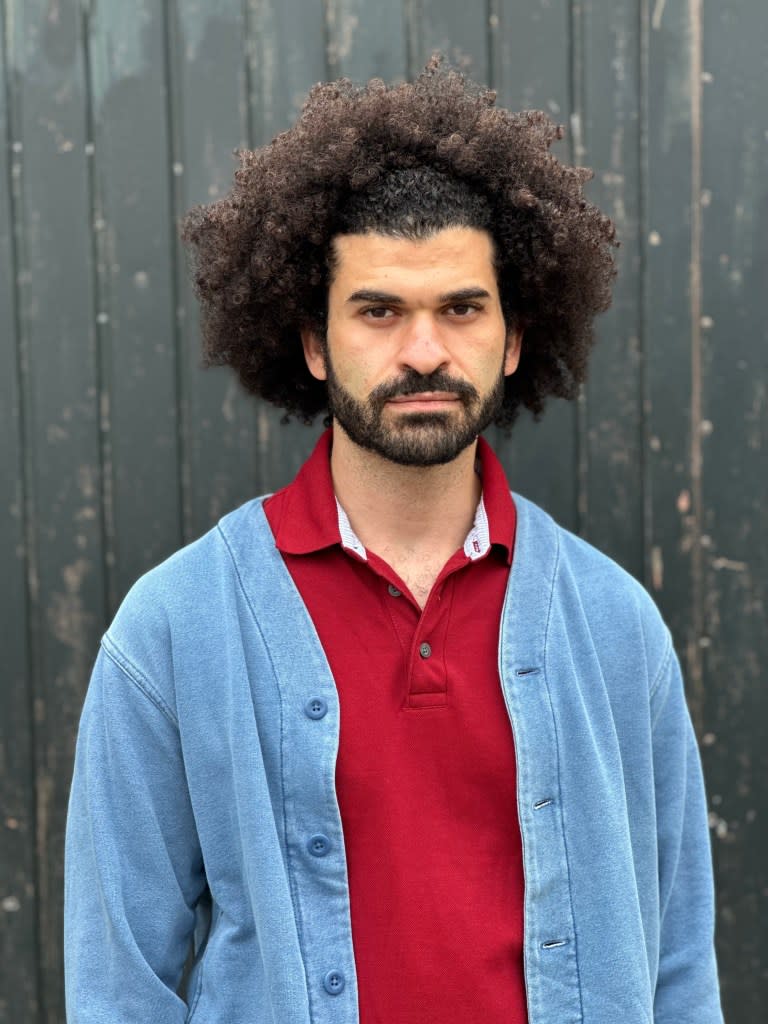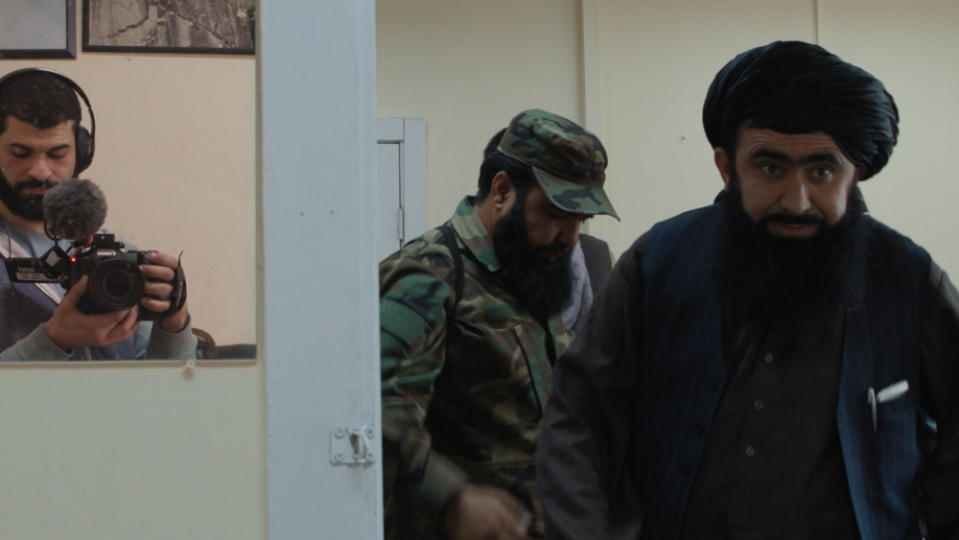Venice Documentary ‘Hollywoodgate’ Offers Gripping Portrait of Taliban Rule After Humiliating U.S. Retreat From Afghanistan: ‘What Was the War For?’
- Oops!Something went wrong.Please try again later.
- Oops!Something went wrong.Please try again later.
- Oops!Something went wrong.Please try again later.

When the last American transport plane left the tarmac at Kabul’s international airport in August 2021, ending a chaotic withdrawal from Afghanistan and marking an unceremonious conclusion to what had been known as the “forever war,” the U.S. left more than unfulfilled promises and unanswered questions in its wake: Also left behind was more than $7 billion in military equipment, now in the hands of an Islamist government that rose to power not at the ballot box, but at the barrel of a gun.
What would become of all that sophisticated weaponry is a question that hung over the heads of the war-weary Afghan people, who after two decades of American occupation and brutal Taliban insurgency saw their dwindling hopes of democracy fade to black. It is a question, too, that hangs over “Hollywoodgate,” an arresting, verité portrait of the Taliban’s transition from a fundamentalist militia to a military regime that premieres Out of Competition at the Venice Film Festival before screening at Telluride.
More from Variety
Directed by Ibrahim Nash’at, a veteran Egyptian journalist and first-time feature filmmaker, “Hollywoodgate” is a Rolling Narratives production in association with Jouzour Film Production, Cottage M and RaeFilm Studios. It’s produced by Oscar-nominated Syrian filmmaker Talal Derki (“Of Fathers and Sons”), Academy Award winner Odessa Rae (“Navalny”) and Oscar winner and three-time nominee Shane Boris (“Navalny”). U.S. sales are being handled by United Talent Agency, while Cinephil is handling world sales.

The film begins as the final U.S. plane has departed Kabul, as scenes of the humiliating American retreat — with thousands of Afghans storming the tarmac at Hamid Karzai International Airport, desperate to board the last flights out of the country — are broadcast around the world. A pall has settled over the city; Kabul, Nash’at says, is like a “ghost town” when he arrives just days later, the eerie quiet punctuated by the sounds of “euphoric” Taliban soldiers firing victoriously into the air.
Nash’at had been granted unprecedented access to follow the Taliban as they attempted to build a post-occupation government and convince a skeptical international community that their intentions were good. The filmmaker was determined, however, not to simply be a mouthpiece for the new regime, which ruled Afghanistan with an iron fist when it was last in power in the 1990s. “What was very clear was that I would show it through my eyes — I will transform the reality as I see it,” he tells Variety.
Armed with a handheld camera, Nash’at accompanies the new head of Afghanistan’s air force, Malawi Mansour — a Talib official whose father was killed by American soldiers — and a former fighter named Mukhtar, who’s set on climbing the ranks of the new Afghan army and avenging the war. The director’s access is unique but fraught; the Taliban are wary, if not outright hostile, as his camera follows them around their new military headquarters. “If his intentions are bad, he will die soon,” Mansour remarks to a subordinate.
With the departure of U.S. and allied forces, Taliban officials were handed the keys to Hollywood Gate: an abandoned American base in Kabul reputed to have been a secret CIA station. Signs of the hasty American withdrawal are apparent, not only in the flotsam of everyday life — a Dallas Cowboys beer mug, self-help books and batteries and shampoo, half-empty bottles of Johnnie Walker whiskey — but in the computers smashed to pieces by U.S. staffers desperate to ensure no sensitive documents fell into Taliban hands.
But what to do about that cache of small arms and munitions, B-35 bombers and Black Hawk helicopters, and other military equipment left behind? With the American-trained Afghan military and police forces swiftly overrun by the Taliban in the summer of 2021, the U.S. summarily pulled out of Afghanistan, seemingly overnight. The abandoned aircraft at Hollywood Gate were deliberately sabotaged by American troops before their departure, but the base was equipped with many of the spare parts needed to repair them. Early in the film, Mansour orders his soldiers to inventory the stockpile and fix what they can, hoping to build a formidable army from the very military machine the Taliban spent 20 years fighting against.

That irony, says Academy Award-winning producer Boris (“Navalny”), is indicative of the “deep failure” of the American undertaking, launched in the aftermath of the Sept. 11 terrorist attacks. More than two decades later, the Taliban are back in power and stronger than before, after a grueling war that claimed well north of 100,000 lives and cost American taxpayers more than $2 trillion — an estimated $300 million a day, every day, for 20 years. The fate of the Afghan people, meanwhile, has never been less certain. “What was the war for?” asks Boris.
It’s a question never directly posed or answered by Nash’at, whose fly-on-the-wall presence documents the quotidian aspects of life in Hollywood Gate, letting the details speak for themselves. Early on, the filmmaker accompanies Mansour and his underlings as they take stock of the inventory left in a cavernous warehouse on the base, rifling through drawers of medicine left behind by the Americans and checking the expiration dates by flashlight. Ten months later, the commander returns and finds the warehouse still dark; no one has changed the lightbulbs, and the medicine has expired — a sly commentary on the stark difference between running a ragtag militia in the mountains and running a functioning government.
Threaded throughout “Hollywoodgate” are also glimpses of how dramatically life for Afghan women has changed since the return of the Taliban. In one telling scene, as Mansour frets over how he’ll find the funds to pay his staff, he casually mentions marrying off a few female subordinates to his jihadist fighters. Delivered with a smile, it is a chilling reminder of how the Taliban’s strict interpretation of sharia law drastically rolled back women’s rights during their previous stint in power. (So, too, are scenes of a female Afghan newscaster, newly forced to wear a face covering as she reads the day’s headlines.) Later, on a rare day when Nash’at is granted permission to film on the streets of Kabul, which have been turned to filthy slush by a snowstorm, he captures a burqa-clad beggar and her child huddled in the middle of the road, pleading at passing motorists.
Nearly a year of living and working under the Taliban wore down Nash’at, who almost daily had to fight pitched battles with bureaucrats and functionaries to maintain tenuous access that could be yanked away at any moment. The grind, he says, made him feel like Sisyphus “having to push the rock up, and then it falls down on me.” The frustrations grew; in one off-camera instance he snapped, lashing out at Mansour in a tirade of Arabic profanities. (Nash’at was saved by his translator, who told the Pashto-speaking commander the invectives were directed at himself.)
The terrible sadness Nash’at felt over the plight of the Afghan people also weighed heavily on him. “Because I have this camera, I was kept away from the daily suffering of the Afghans. Yet I feel it everywhere I go,” he observes in “Hollywoodgate.” To stay focused, he would recall a piece of advice from his mentor, the Syrian documentarian Derki, who embedded with a jihadist father training his sons to take up arms in the Syrian civil war while filming his Oscar-nominated documentary “Of Fathers and Sons.”
The trick, Derki told him, was to concentrate entirely on the images he was recording and not let himself get distracted by anything happening outside the frame, no matter how frightful or appalling. It was advice that grounded Nash’at throughout the making of his brave, urgent film. “I’m in the monitor, I’m not aware of what’s happening,” he says. “I become the camera.”
Best of Variety
Sign up for Variety’s Newsletter. For the latest news, follow us on Facebook, Twitter, and Instagram.

